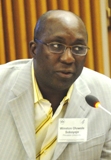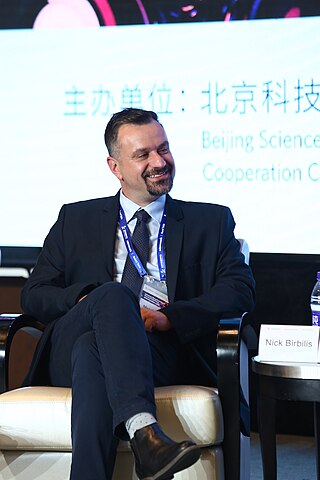Related Research Articles
Computer science and engineering (CSE) is an academic program at many universities which comprises scientific and engineering aspects of computing. CSE is also a term often used in Europe to translate the name of engineering informatics academic programs. It is offered in both undergraduate as well postgraduate with specializations.

Battelle Memorial Institute is a private nonprofit applied science and technology development company headquartered in Columbus, Ohio. The institute opened in 1929 but traces its origins to the 1923 will of Ohio industrialist Gordon Battelle which provided for its creation and his mother Annie Maude Norton Battelle who left the bulk of the family fortune to the institute after her death in 1925. Originally focusing on contract research and development work in the areas of metals and material science, Battelle is now an international science and technology enterprise that explores emerging areas of science, develops and commercializes technology, and manages laboratories for customers.
Marcel Pourbaix was a Belgian chemist and pianist. He performed his most well known research at the University of Brussels, studying corrosion. His biggest achievement is the derivation of potential-pH, better known as “Pourbaix Diagrams”. Pourbaix Diagrams are thermodynamic charts constructed using the Nernst equation and visualize the relationship between possible phases of a system, bounded by lines representing the reactions that transport between them. They can be read much like a phase diagram.
CSA was a division of Cambridge Information Group and provider of online databases, based in Bethesda, Maryland, before merging with ProQuest of Ann Arbor, Michigan, in 2007. CSA hosted databases of abstracts and developed taxonomic indexing of scholarly articles. These databases were hosted on the CSA Illumina platform and were available alongside add-on products like CSA Illustrata. The company produced numerous bibliographic databases in different fields of the arts and humanities, natural and social sciences, and technology. Thus, coverage included materials science, environmental sciences and pollution management, biological sciences, aquatic sciences and fisheries, biotechnology, engineering, computer science, sociology, linguistics, and other areas.

High-temperature corrosion is a mechanism of corrosion that takes place when gas turbines, diesel engines, furnaces or other machinery come in contact with hot gas containing certain contaminants. Fuel sometimes contains vanadium compounds or sulfates which can form compounds during combustion having a low melting point. These liquid melted salts are strongly corrosive for stainless steel and other alloys normally inert against the corrosion and high temperatures. Other high-temperature corrosions include high-temperature oxidation, sulfidation and carbonization. High temperature oxidation and other corrosion types are commonly modelled using the Deal-Grove model to account for diffusion and reaction processes.
Crevice corrosion refers to corrosion occurring in occluded spaces such as interstices in which a stagnant solution is trapped and not renewed. These spaces are generally called crevices. Examples of crevices are gaps and contact areas between parts, under gaskets or seals, inside cracks and seams, spaces filled with deposits and under sludge piles.
Corrosion engineering is an engineering specialty that applies scientific, technical, engineering skills, and knowledge of natural laws and physical resources to design and implement materials, structures, devices, systems, and procedures to manage corrosion. From a holistic perspective, corrosion is the phenomenon of metals returning to the state they are found in nature. The driving force that causes metals to corrode is a consequence of their temporary existence in metallic form. To produce metals starting from naturally occurring minerals and ores, it is necessary to provide a certain amount of energy, e.g. Iron ore in a blast furnace. It is therefore thermodynamically inevitable that these metals when exposed to various environments would revert to their state found in nature. Corrosion and corrosion engineering thus involves a study of chemical kinetics, thermodynamics, electrochemistry and materials science.

Winston Wole Soboyejo commonly known as "Wole" is an American Scientist of Yoruba Nigerian parentage. He is a materials scientist whose research focuses on biomaterials and the use of nanoparticles for the detection and treatment of disease, the mechanical properties of materials, and the use of materials science to promote global development. He was appointed President at SUNY Polytechnic Institute to begin on October 2, 2023.
Herbert Henry Uhlig was an American physical chemist who studied corrosion.

Watts Hall was a building on the Ohio State University campus, in Columbus, Ohio, United States. The building was named after Arthur S. Watts, a former head of the Department of Ceramic Engineering, and former president of the American Ceramic Society. It housed the OSU Department of Materials Science and Engineering before being demolished in 2022 to make way for the second phase of the BMEC project.
Alison Jean Davenport is the Professor of Corrosion Science at the School of Metallurgy and Materials, University of Birmingham.

Nick Birbilis is an Australian engineer and academic. He is presently the Executive Dean of the Faculty of Science, Engineering, and Built Environment, at Deakin University. Birbilis was previously the Dean, and Deputy Dean of the College of Engineering and Computer Science at the Australian National University. He is of Greek-Australian background. Birbilis works in the field of materials science and engineering, having made contributions in the area of materials design, materials durability and materials characterisation. He is a Fellow of the Electrochemical Society (US), a Fellow of NACE (US), a fellow of Engineers Australia, a Fellow of the International Society of Electrochemistry (ISE)., and a Fellow of ASM International.
Bilge Yıldız is a Professor of Nuclear Science, Materials Science and Engineering at the Massachusetts Institute of Technology. She develops new materials for energy conversion in harsh environments. These include solid oxide fuel cells and corrosion-resistant materials for nuclear energy regeneration.

Mary Catherine Juhas is an American engineer. She is an associate vice president in the Office of Research and associate professor of materials science and engineering in the College of Engineering at Ohio State University. She is a Fellow of the American Society for Metals and inducted into the Ohio Women's Hall of Fame.
Abraham Badu-Tawiah is a Ghanaian scientist who is an Associate Professor of Chemistry at the Ohio State University. His research considers the development of mass spectrometry for the detection of disease. In 2017 he was awarded the American Chemical Society Arthur F. Findeis prize and in 2020 a Sloan Research Fellowship.
Kwadwo Osseo-Asare is an Ghanaian materials scientist who is Distinguished Professor of Materials Science and Engineering at the Pennsylvania State University. He was awarded the American Institute of Mining, Metallurgical, and Petroleum Engineers Gold Medal in 1997. He was elected a member of the National Academy of Engineering in 2004 for contributions to the fundamental understanding of interfacial phenomena in leaching and solvent extraction.
Melvin Romanoff was a physical chemist and corrosion engineer who specialized and wrote books about underground and soil corrosion. He worked for many years at the National Bureau of standards. His tenure at The National Bureau of Standards later renamed the National Institute of Standards and Technology was from 1937 to 1970. He was inducted into the hall of fame in 1995. For many years, NACE, the National Association of Corrosion Engineers, now NACE International presented a Melvin Romanoff award in his honor.

John L. Volakis is an American engineer, educator and writer. He is the Dean of the College of Engineering and Computing at Florida International University (FIU). He was born in Chios, Greece on May 13, 1956, and immigrated to the United States in 1973. He is an IEEE, ACES, AAAS and NAI Fellow and a recipient of the URSI Gold Medal. He served as the IEEE Antennas and Propagation Society President (2004), and as chair and Vice Chair of the International Radio Science Union (URSI), Commission B (2017-2023).
William J. van Ooij is a retired University of Cincinnati professor known for elucidating the mechanisms of brass-rubber adhesion in tires, and as the founder of corrosion resistant coatings company Ecosil Technologies
References
- ↑ Read "Memorial Tributes: Volume 5" at NAP.edu. Archived from the original on 2021-02-09. Retrieved 2021-02-08.
- ↑ Memorial tributes. Volume 5. National Academy of Engineering. Washington, D.C.: National Academy Press. 1992. ISBN 9780309046893. OCLC 614634019.
{{cite book}}: CS1 maint: others (link) - ↑ Evans, Ulick Richardson (1968). The corrosion and oxidation of metals : supplementary volume. London: Arnold. ISBN 0-7131-2197-1. OCLC 71375752.
- ↑ Fontana, Mars G. (1978). Corrosion engineering. Greene, Norbert D. (2d ed.). New York: McGraw-Hill. ISBN 0-07-021461-1. OCLC 3223828. Archived from the original on 2021-02-09. Retrieved 2021-02-08.
- ↑ "US News best global universities Europe 2021".
- ↑ Sidky P.S and Hocking M.G masters degree course in "Corrosion of Engineering Materials" Lecture Course notes and recommended books list Imperial College London first written 1994.
- ↑ "Special Collections Registry". library.osu.edu. Retrieved 2021-02-18.
- ↑ Fontana, Mars Guy (1957). Corrosion, a compilation. Columbus, Ohio: Press of Hollenback. Archived from the original on 2021-02-09. Retrieved 2021-02-08.
- ↑ Fontana, M. G. (1957). "Corrosion : a compilation". S2CID 136946654. Archived from the original on 2021-02-09. Retrieved 2021-02-08.
{{cite journal}}: Cite journal requires|journal=(help) - ↑ "Welcome to the Fontana Corrosion Center". The Fontana Corrosion Center. 2013-10-02. Retrieved 2021-02-18.
- ↑ The Science and Design of Engineering Materials, Schaffer, et al.
- ↑ Materials Science and Engineering; An Introduction, Callister
- ↑ "Mars G. Fontana, Engineering | Office of Research" . Retrieved 2021-02-18.
- ↑ "Mars G. Fontana Laboratories | Time and Change: Building the Future". buildingthefuture.osu.edu. Retrieved 2021-02-18.
- ↑ "Ohio State University professor honored for technology commercialization". Ohio State University professor honored for technology commercialization. Retrieved 2021-02-18.